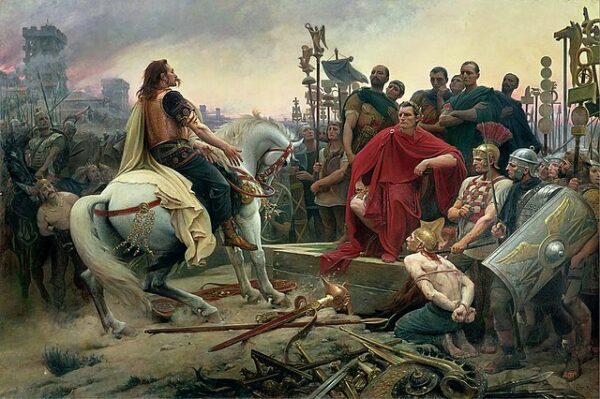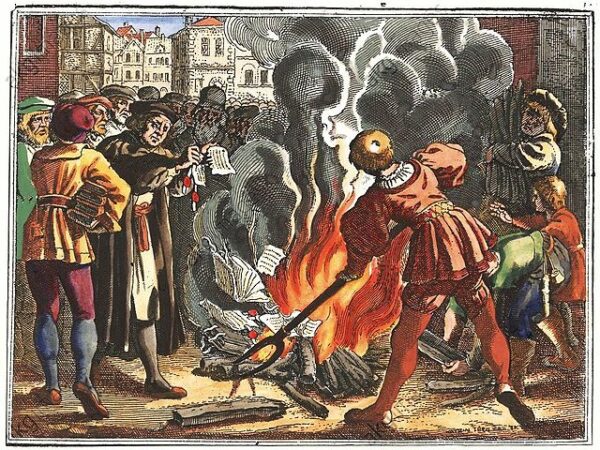On October 3, 52 BC, the Gallic Wars reached a decisive turning point when Vercingetorix, the charismatic leader of the Gauls, surrendered to Julius Caesar, marking the end of the Siege of Alesia. This surrender signaled not only the defeat of the Gallic rebellion but also solidified Caesar’s control over Gaul, bringing much of modern-day France under Roman rule.
The Gallic Wars had raged for several years, with the Gauls, a confederation of Celtic tribes, fiercely resisting Roman expansion into their territory. Vercingetorix, a nobleman from the Arverni tribe, emerged as the leader of the resistance. Uniting various tribes under his command, he launched a coordinated campaign against Caesar’s legions, using hit-and-run tactics and scorched-earth policies to challenge the Roman army.
By the summer of 52 BCE, Vercingetorix and his forces had retreated to the fortified hilltop town of Alesia, located in present-day Burgundy. The town’s strategic location made it an ideal defensive position, surrounded by steep terrain and natural obstacles. The Gallic leader hoped that by holding out in Alesia, he could outlast Caesar’s army and force a Roman withdrawal. His plan was bolstered by the fact that reinforcements from various Gallic tribes were expected to come to his aid.
However, Caesar, a master of siege warfare, laid a sophisticated trap for the Gauls. Rather than attacking the heavily fortified town directly, he ordered his legions to construct two massive walls of fortifications around Alesia: an inner wall to prevent the besieged Gauls from escaping and an outer wall to repel any relief forces attempting to break the siege. This double circumvallation effectively sealed off Vercingetorix and his army inside Alesia while also preparing for the inevitable arrival of Gallic reinforcements.
The siege dragged on for weeks, with the Gauls inside Alesia suffering from food shortages and disease. Despite several attempts to break through Caesar’s fortifications, Vercingetorix was unable to breach the Roman lines. Meanwhile, a massive Gallic relief force, estimated to number over 100,000 warriors, assembled outside the Roman camp and launched several assaults on Caesar’s outer wall.
Caesar’s legions, however, held firm, repelling wave after wave of Gallic attacks. In one of the most dramatic moments of the siege, the Roman cavalry, under the command of Caesar’s trusted lieutenant, Mark Antony, managed to outflank the Gauls and launch a surprise counterattack, further demoralizing the Gallic forces. With the relief force in disarray and the situation inside Alesia growing increasingly desperate, Vercingetorix was left with no choice but to surrender.
The exact details of Vercingetorix’s surrender have become the stuff of legend. According to ancient sources, the Gallic leader rode out from Alesia on horseback, dressed in his finest armor, and presented himself to Caesar. Some accounts suggest that he dramatically threw his weapons at Caesar’s feet, a symbolic gesture of submission. Regardless of the precise details, Vercingetorix’s surrender marked the end of the Gallic resistance.
Following his capture, Vercingetorix was taken to Rome, where he was paraded in Caesar’s triumph, a grand celebration of the Roman general’s victories. After the triumph, the Gallic leader was executed, a grim reminder of Rome’s harsh treatment of its enemies.
The fall of Alesia and Vercingetorix’s surrender had far-reaching consequences. With the defeat of the Gallic tribes, Caesar completed his conquest of Gaul, bringing the vast territory under Roman control. This victory significantly enhanced Caesar’s political and military reputation, helping pave the way for his eventual rise to power as the ruler of Rome.
In the years following Alesia, Gaul would be fully integrated into the Roman Empire, its people subjected to Roman rule, taxation, and cultural assimilation. Caesar’s victory over Vercingetorix not only marked the end of the Gallic Wars but also the beginning of a new chapter in the history of both Rome and Gaul.






